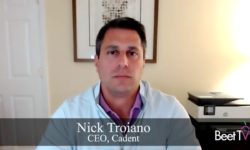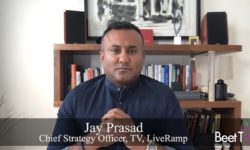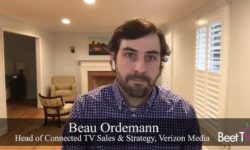A pioneer in the addressable TV advertising space is ramping up to enable the latest incarnation of the opportunity.
INVIDI began 18 years ago, helping TV providers enable their ad inventory for targeted buying, primarily through set-top boxes.
In this video interview with Beet.TV, Michael Kubin explains what comes next.
From box to everywhere
“The distribution of addressable television was done has occurred exclusively through the digital set-top box on linear addressable in the two minutes that are available to the distributors, that are made available to the distributors by the programmers,” Kubin says.
“That’s fine, that’s a great business. It has attracted hundreds of advertisers with many, many success stories as to how well that’s worked. But we all realise that there are constraints there. And one of the constraints is the way the consumer has learned to get access to television.
“It’s no longer (about) just linear addressability. It is now (also) via streaming, OTT, and that is a huge business and a growing business at a rapid pace. That is an area in which we have to play. We’ve committed to playing, and we’re going into that very aggressively.
You’ll be hearing some news from us about that in this year, hopefully in the next few months. Basically wherever the consumer chooses to access television programming, that is going to be an entry point for us in terms of being able to use our technology and target the right individual with the right message.”
Three frictions
Kubin also set out what he sees as three key friction points in the evolution of addressable TV ad buying.
He was speaking after the release of Era Of Addressable, a survey of 522 ad-buying decision makers – commissioned from Forrester by DISH Media, Cadent, Canoe, Comscore, INVIDI Technologies, LiveRamp, Verizon Media, ViacomCBS and WarnerMedia.
The research shows advertisers are “applying addressable TV across the full customer lifecycle”.
Kubin’s takeaways:
1. Distribution
“The biggest challenge is that there is not a single distribution footprint for addressability – There are several. That is a challenge to the buyer today. If you’re a planner or a buyer and you’re looking at doing an addressable campaign or including addressability in your campaign, you’re going to have to take into account the fact that it’s not one-stop shopping.
“Distribution is fragmented and. In order for the business to really coalesce and realise its potential, those footprints need to somehow come together. That’s the direction that ultimately it’s going to take.”
2. Programming
“Until now, addressability has been basically available only in the two local minutes that the distributors get from programmers and that’s fine. As the report points out, it’s a $3.5 billion business and significantly important to a lot of marketers, but it’s now getting into the programmer minutes, the inventory that programmers actually own.
“That is a huge step forward, that integrates the addressable availability into programme content, as opposed to being, in many cases, outside of content. So that’s a great step forward. ”
3. Data
“Data is the fuel that makes addressability work. There is a lot of data that currently exist – particularly in this country, in the United States, we have a lot of data available. If the marketer wants to find not only the specific target that may buy the product, but really where in the funnel, where in that consumer journey the consumer is, that there is data available that can target it specifically to where that exists.
“The challenge there is a more global one where we have found as we distribute addressability internationally, that same access and availability of data doesn’t exist.”
You are watching “The Transformation of Television: Embracing the Era of Addressable TV,” a Beet.TV leadership series presented by Dish Media. For more videos, please visit this page.


































